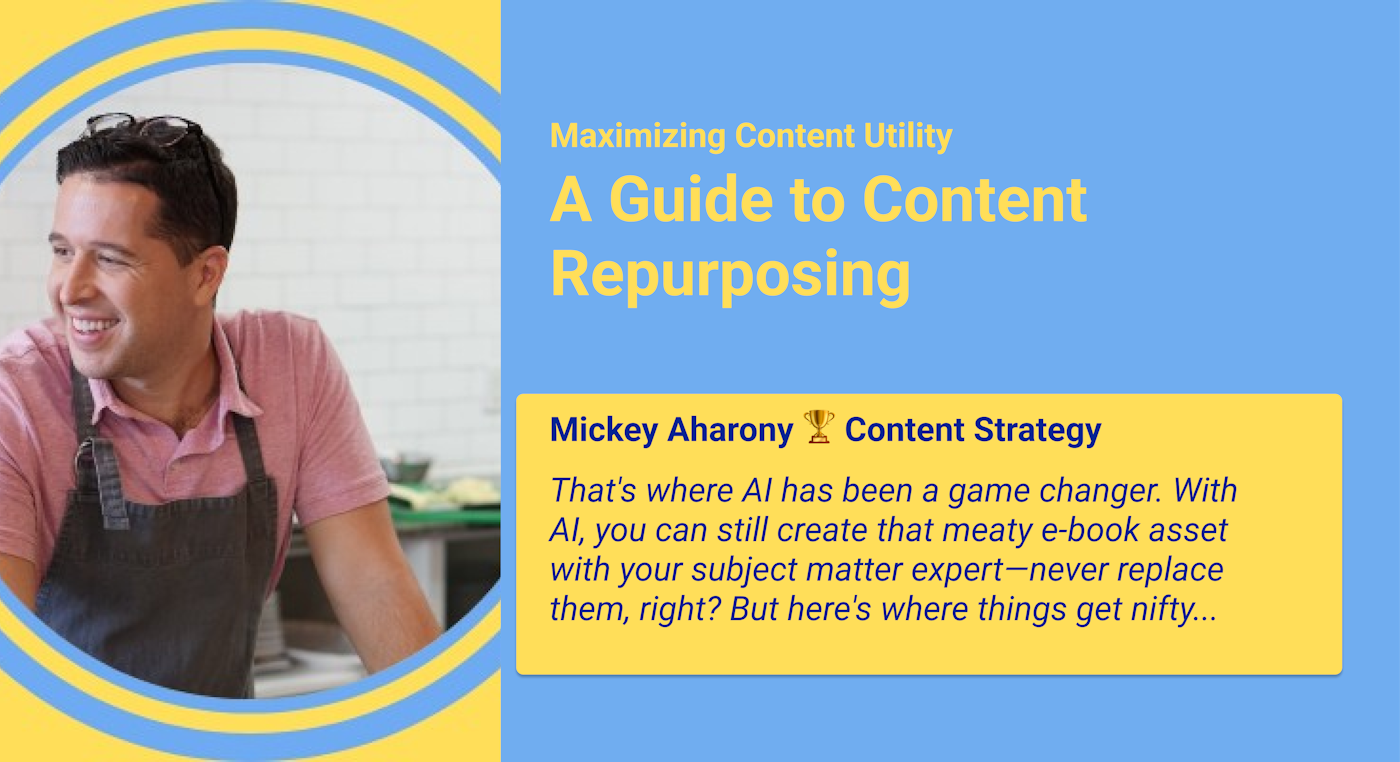Maximizing Content Utility: A Guide to Content Repurposing
The Significance of Content Repurposing
A notable 42% of marketers have discovered that updating and reworking existing content is a pivotal element in their successful marketing strategies, as highlighted by SEMrush's State of Content Marketing Report. The practice of repurposing content not only allows for the optimization of resources, but it also enhances SEO, extends reach, builds brand awareness, and increases engagement.
Evaluating Content for Repurposing
Selecting the right content to repurpose involves focusing on evergreen materials—those pieces that maintain relevance over time and consistently engage the audience. Pinpointing these valuable pieces is crucial in developing a repurposing strategy that can rejuvenate and extend the life of your content.
Approaches to Repurposing Content
Content repurposing involves transforming a robust piece of content, such as an in-depth guide or a thorough report, into various formats that cater to different platforms and audiences. The goal is to adapt the material thoughtfully, ensuring it fits the new format and resonates with a potentially different audience.

Expanding Reach through Interactive Content
A significant 79% of marketers are taking their product content to new heights by incorporating interactive elements. Linearity.io reports that 88% of marketers affirm that interactive content effectively sets their brand apart from competitors. This could involve converting a static infographic into an interactive experience or crafting a how-to guide into a dynamic step-by-step video.
Utilizing AI for Content Repurposing
Mickey Aharony, a content strategist, has observed the transformative effects of AI on content repurposing. He notes, "Over the last year and a half, my approach to content repurposing has really evolved, especially with all these AI tools that have hit the market." AI can facilitate the breakdown of an e-book into a series of blog posts or social media snippets, aiding in the generation of drafts and outlines. This tech integration allows for agile responses to audience interactions and fine-tuning of content strategies.
Ahrony goes on to share “Sometimes you'll find out that a theme you thought was hot stuff doesn't really resonate, but your audience is buzzing about something else entirely.’ With AI's analytical capabilities, marketers can swiftly identify trends and pivot their content to align with audience interests. This dynamic approach to repurposing can lead to discovering unexpected topics that captivate the audience, opening up new avenues for engagement and conversation. By leveraging AI to monitor audience reactions, content creators can refine their repurposing efforts, ensuring that they are not just recycling material, but are actively participating in the dialogues that matter most to their consumers.
Prolonging Content Life and Reach
By repurposing content, its active lifespan is extended, ensuring that it continues to serve your marketing needs well beyond its initial publication. As Right Source Marketing points out, this tactic can introduce your content to new audiences and enhance web traffic, effectively increasing the value of your content investment. With 65% of businesses finding content repurposing more impactful than the creation of new content, the benefits of this strategy are undeniable.
Practical Tips for Repurposing Content Across Different Media
Adapting content effectively across different media requires an understanding of each platform's unique features and audience expectations. For example, a comprehensive report can be split into a series of blog posts, each focusing on a distinct aspect of the research. These posts can then be shared on social media platforms, with key insights summarized into compact pieces that encourage comments and shares. Likewise, webinars can be transformed into instructional videos or podcast episodes, making the content accessible in formats that cater to various user preferences.

Maintaining Quality and Consistency
It's essential to keep the core message consistent throughout all repurposed content. Whether you're turning a blog post into a series of tweets or a white paper into an infographic, the quality of the information and the voice of your brand should remain clear. Consistent branding and messaging reassure your audience that they're receiving the same value, regardless of the content format or channel they're engaging with.
Measuring Success and Adapting Strategies
To truly understand the impact of your repurposed content, you must measure its performance. Analytics can reveal which pieces connect most with your audience and which platforms are driving the most engagement. This data can then inform future repurposing efforts, ensuring that your strategy remains aligned with audience behavior and preferences.
Roy Rosell, Sr. Manager of Product Marketing at VMware, emphasizes the need for a comprehensive approach: "Repurposing content is absolutely essential if you want to maximize the reach of each piece of content you create." By analyzing the performance of different content formats, you can refine your approach and optimize the content for each specific platform.
Conclusion
Repurposing content isn't just a tactic to extend the shelf life of your existing assets; it's a strategic move to extract maximum value and achieve broader reach. By understanding the impact of content repurposing, assessing content for repurposing potential, and implementing practical strategies across different media, you can ensure that your marketing efforts are both efficient and effective.
As Rosell says, “your content should work for you”. As you adapt and evolve your content to meet the needs of your audience, you'll discover that repurposing is a smart business strategy that keeps you connected with your audience and ahead of the competition.
From the Experts

"At Captain, our approach to content repurposing begins with a detailed, well-researched piece of content—typically a thought piece or a long-form article. It's packed with data, insights, and expert commentary, giving us the full narrative and all the details we need. From there, we can start slicing it up for different channels and media types. When you're looking at content repurposing, you've really got to consider what formats your audience is most responsive to. It's awesome to have a detailed piece of content for those who want to dive deep into the topic. But in marketing, you also want to make sure you're telling a story that fits the channel you're using. Like on TikTok, you've got short-form video, and on Instagram, you're working with just a single image. So, it's crucial to consider the channel, the media, and the audience when you're repurposing content. But again, how we do things at Kapton is by taking a deep dive into the topic to create that long-form piece as our anchor content. Then we extract and adapt from there."

"Over the last year and a half, my approach to content repurposing has really evolved, especially with all these AI tools that have hit the market. So, back in the day, it might've taken us a good three to four months from the initial idea to actually executing a whole content strategy. That's talking to subject matter experts, whipping up a report, or say you've got this massive 4,000-word e-book. This e-book would come with a blog, an organic social campaign, some paid ads. Then, you'd break it down into four themes, spin off four white papers, each with their own campaigns, blogs, social content, ads, and then throw in infographics and all sorts of social images and graphics. Creating all this content? It used to be a three to four month ordeal. Then you'd slowly start rolling it out over the next quarter. But sometimes, you'd hit a snag because maybe the budget wasn't there to promote everything, or some of the assets didn't perform as well as you'd hoped. That's where AI has been a game changer. With AI, you can still create that meaty e-book asset with your subject matter expert—never replace them, right? But here's where things get nifty. You can use AI to dip your toes in the water, test the audience a bit. Once you've got your blog and organic social content, you can take themes from the e-book, test them out on your audience on LinkedIn—run polls, ask questions, spark conversations. Sometimes you'll find out that a theme you thought was hot stuff doesn't really resonate, but your audience is buzzing about something else entirely. And that can steer you in a whole new direction. This way, you're not waiting months to publish; you're getting your message out there quick. And once you've pinpointed what's really getting pure engagement, you can whip up a blog on that. It's good for your SEO, gets more content out there. Then you can start cranking out those e-books and whatever else, with AI helping you draft outlines and working alongside your subject matter expert—or you can tackle the writing yourself. It just speeds everything up. And then, there's video. There are so many AI video tools out there now. You've got AI avatars—you can create one of your internal thought leader or pick a generic one. Or just go straight from text to video. There's a bunch of ways to turn written content into video content now. And with Google moving from SEO to Generative Engine Optimization—we're probably gonna see video becoming more and more key. But that's a whole other conversation."





